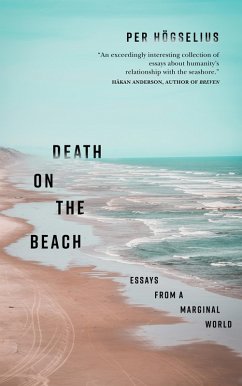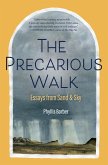A wondrous and haunting deep-dive into landscape and culture.
"Countless are they, the people who for one reason or another or for no reason at all have met their fate on the beach.
This fascinating essay collection, translated from Swedish, walks global shores, looks to the sea and transcends the everyday. Beaches have shadows. They are places of tragedy that look upon the unfathomable abyss of the ocean. Per Högselius skirts our history, shipwrecks and bodies, relics of war and vanished lives. He draws on his encounters with painters, writers and movie directors. He invokes Casper David Frinedrich, Frankenstein and Jaws. Prepare for a haunting journey that leaves you fragile and shows you wonders.
"Countless are they, the people who for one reason or another or for no reason at all have met their fate on the beach.
This fascinating essay collection, translated from Swedish, walks global shores, looks to the sea and transcends the everyday. Beaches have shadows. They are places of tragedy that look upon the unfathomable abyss of the ocean. Per Högselius skirts our history, shipwrecks and bodies, relics of war and vanished lives. He draws on his encounters with painters, writers and movie directors. He invokes Casper David Frinedrich, Frankenstein and Jaws. Prepare for a haunting journey that leaves you fragile and shows you wonders.
Dieser Download kann aus rechtlichen Gründen nur mit Rechnungsadresse in A, D ausgeliefert werden.
"A captivating and innovative book of essays about how the beach as a geographical and mythical space between land and sea has functioned as an arena for death and violence - in literature, art, film and real life."
Borås Tidning
"Deeply compassionate, provokes novel thoughts and fuels introspection."
Lundagård
"Per Högselius has written an exceedingly interesting collection of essays about humanity's relationship with the seashore, now and in the past. He brings his reader along to various epochs and examines how shores and beaches have been treated in art, literature, myth and film... It might seem like a collection of loose ends, but Högselius expertly pulls them all together in this well-written book, not least by means of his own experiences as a wanderer on the shores of this world."
Håkan Andersson in Gotlands Tidningar
"That beaches are, on the whole, very bleak places, is convincingly demonstrated in Per Högselius' Death on the Beach, a lovely, compact little collection of essays which gives these playgrounds of horror and sorrow a thorough onceover, through the twin lenses of art and literature."
Petter Lindgren in Aftonbladet
"In order to explore the densification of darkness that constitutes the cultural background radiation of beach life, Högselius has put together a shifting prism of examples. He skilfully highlights the ambivalence that characterises our relationship with the seashore. The book's chapters each deal with a facet of the larger beach theme: shipwrecks, tides, the dying man's longing for the sea, fleeing from one shore to another, the beach as a place of memory and so on. At the same time, they are filled with so much more than that. As an essayist, Högselius is catlike, he moves nimbly and with admirable agility between historical periods and specific examples. Under his treatment, the vastest distances between subjects and genres, times and places shrink. Before you know it, you have travelled very far, very fast without ever noticing... [Högselius] is a very ambitious stylist. The success of the book also rests on the fact that Death on the Beach isn't just an investigative, analytical text. It is also, like all good essays, the product of a distinctive gaze and character: a piece of reality filtered through a temperament. The texts are characterised by a presence, an author who does things - travels, reads, is astonished, turns pages, observes, embraces, discusses, swims, sleeps, goes for walks. It makes them feel more alive, of course, but it also helps to hold the whole affair together."
Gustaf Johansson in Tidskriften Respons
"Högselius' charming musings is one of this captivating book's most outstanding qualities. And as a good essayist, he knows how to balance the universal and the particular, collective culture and private experience, and to add colour to the contours of historical examples with the help of his own personal experiences and unique memories. Like in the chapter entitled 'Flight', where an overarching narrative about the countless corpses that washed ashore to litter the beaches of the Baltic Sea at the end of the Second World War blends with the story of how the author during a stay in Borum on Gotland first sees the photograph of Alan Kurdi's lifeless body lying at the water's edge. 'Because in the twenty-first century, the seashore remains a place that more than any other reminds us of the fragility of our existence, that everything can fall apart at any moment.'"
Martin Lagerholm in Svenska Dagbladet
"The clichéd images of beach sunsets and seaside summer homes fade like sun-bleached wallpaper against the dark coastal horrors Högselius presents in his collection of beach finds from our cultural history. The beach has always functioned as a border against the unknown and decidedly lethal: sea monsters at the edge of the world, ships carrying plagues, sudden storms, rising tides... That is the strength of this book: even though it ranges through the geography of our planet, it doesn't primarily arouse a yen to travel, but to read."
Anna Blennow in Sydsvenskan
Borås Tidning
"Deeply compassionate, provokes novel thoughts and fuels introspection."
Lundagård
"Per Högselius has written an exceedingly interesting collection of essays about humanity's relationship with the seashore, now and in the past. He brings his reader along to various epochs and examines how shores and beaches have been treated in art, literature, myth and film... It might seem like a collection of loose ends, but Högselius expertly pulls them all together in this well-written book, not least by means of his own experiences as a wanderer on the shores of this world."
Håkan Andersson in Gotlands Tidningar
"That beaches are, on the whole, very bleak places, is convincingly demonstrated in Per Högselius' Death on the Beach, a lovely, compact little collection of essays which gives these playgrounds of horror and sorrow a thorough onceover, through the twin lenses of art and literature."
Petter Lindgren in Aftonbladet
"In order to explore the densification of darkness that constitutes the cultural background radiation of beach life, Högselius has put together a shifting prism of examples. He skilfully highlights the ambivalence that characterises our relationship with the seashore. The book's chapters each deal with a facet of the larger beach theme: shipwrecks, tides, the dying man's longing for the sea, fleeing from one shore to another, the beach as a place of memory and so on. At the same time, they are filled with so much more than that. As an essayist, Högselius is catlike, he moves nimbly and with admirable agility between historical periods and specific examples. Under his treatment, the vastest distances between subjects and genres, times and places shrink. Before you know it, you have travelled very far, very fast without ever noticing... [Högselius] is a very ambitious stylist. The success of the book also rests on the fact that Death on the Beach isn't just an investigative, analytical text. It is also, like all good essays, the product of a distinctive gaze and character: a piece of reality filtered through a temperament. The texts are characterised by a presence, an author who does things - travels, reads, is astonished, turns pages, observes, embraces, discusses, swims, sleeps, goes for walks. It makes them feel more alive, of course, but it also helps to hold the whole affair together."
Gustaf Johansson in Tidskriften Respons
"Högselius' charming musings is one of this captivating book's most outstanding qualities. And as a good essayist, he knows how to balance the universal and the particular, collective culture and private experience, and to add colour to the contours of historical examples with the help of his own personal experiences and unique memories. Like in the chapter entitled 'Flight', where an overarching narrative about the countless corpses that washed ashore to litter the beaches of the Baltic Sea at the end of the Second World War blends with the story of how the author during a stay in Borum on Gotland first sees the photograph of Alan Kurdi's lifeless body lying at the water's edge. 'Because in the twenty-first century, the seashore remains a place that more than any other reminds us of the fragility of our existence, that everything can fall apart at any moment.'"
Martin Lagerholm in Svenska Dagbladet
"The clichéd images of beach sunsets and seaside summer homes fade like sun-bleached wallpaper against the dark coastal horrors Högselius presents in his collection of beach finds from our cultural history. The beach has always functioned as a border against the unknown and decidedly lethal: sea monsters at the edge of the world, ships carrying plagues, sudden storms, rising tides... That is the strength of this book: even though it ranges through the geography of our planet, it doesn't primarily arouse a yen to travel, but to read."
Anna Blennow in Sydsvenskan









